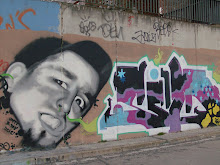
The Pilsner Brewery experience is pretty cool, especially if you've only got a little knowledge about the how and what that goes into beer making. It costs about 130 kc and it wouldn't be very fun if you didn't wait for an English speaking tour. You start off with a general history of movie and a three story model of an old brewhouse. It's then pointed out that Plzeňský Prazdroj makes two of every three beers sold in the Czech Republic (they also own Gambrinus and Kozel). It's also owned by SAB Miller and is the flagship brand of the company, so there's a display of some of Miller's multitudinous international beer brands.
First stop, after a pointless bus ride of about 100 meters, is the coopers' workshop. Cooping, if you don't know, is the dying art of barrel making. The only reason that the guys here are even employed is because of us, the tourists. However, ten of them work here and they've got a pretty cool workshop. The oak for the barrels is aged for ten years before they do anything with it. And their dust collector unit is two stories tall.

Take the pointless bus back to the place you started and enter the presently-being-remodeled brewhouse. There they give you a brief overview of the Plzeňský process.

Germinated barley, roasted and milled, then mixed with water and thirty percent of each batch is roasted, mixed back in, and done again, for a total of three times. It's then unhopped wort. They add hops, in this case some famous stuff from Bohemia and some other type from Moravia that they like to play down. The yeast is added. There's a cold filter process, the beer sits for a short period, then is moved to a larger vat and aged for 12 weeks or so. They like to say this is the original process, but then they also note that improved temperature and pressure technologies have taken the second aging session down from an original time of around 3 months.
Then they take you into this giant modern elevator. Dave noted that he'd played music in clubs with smaller square footage. As soon as the elevator door opens (to get in) your nostrils quail under the weight and strangeness of a slightly sour roasted smell, that I was later to learn, is mostly hops. Then you watch a video on the origins of the ingredients while standing on this quietly turning platform. Then you go the the Hall of Ingredients, where you can sample barley, malt, and hops. The barley is normal cereal grain, the malt would be good as breakfast cereal, and I'd advise you not to eat the hops. Think alfalfa that gives your mouth a dry-bitter pucker.

You're then taken to some boilers and mash-tuns that are set-up as models. After that you get to peek into the real plant. These things are gigantic, there's a full story drop from the upper level to the lower, and the second step tanks are about twice as large.
After this you get to see a small museum with artifacts and documents. Here's a brief version: in 1845 or so the town residents began complaining about the quality of the beer, and dumped a bunch out on the mayor's front steps. The roughly three hundred families in town with official brewing licenses got together and amalgamated. (Many of these families are still minority stakeholders.) The beer became the pride of the town. Somewhere around the turn of the last century they began winning lots of prizes. You get to see some of these and look at cups that Franz Joseph, Emperor of Austria and King of Bohemia, drank from. It even survived the privations of Nazism and Communist nationalization. Then it's time for the fun stuff.


You go down stairs to the old cellars. Our guide, who was pretty cool and funny despite his broken English, told us there's something like nine kilometers of hallway hidden under the brewery. Most of which is unused now. It's also pretty cold. They used to keep it even colder by harvesting a year's worth of ice from the river in winter and dropping it down into this giant refrigeration vault. You get to see the barrels of beer that they brew especially for the tourists.

The marks on the barrel are as follows, strength:12º [about 5%], starting date: 11th of February, starting temperature: 5º C, and the type of yeast used, followed by the temperature on different days. Then you get to taste the beer! Yummy, yummy stuff. More on that in the next post. After that they take you topside, say “That's all,” and point you towards the gift shop.



